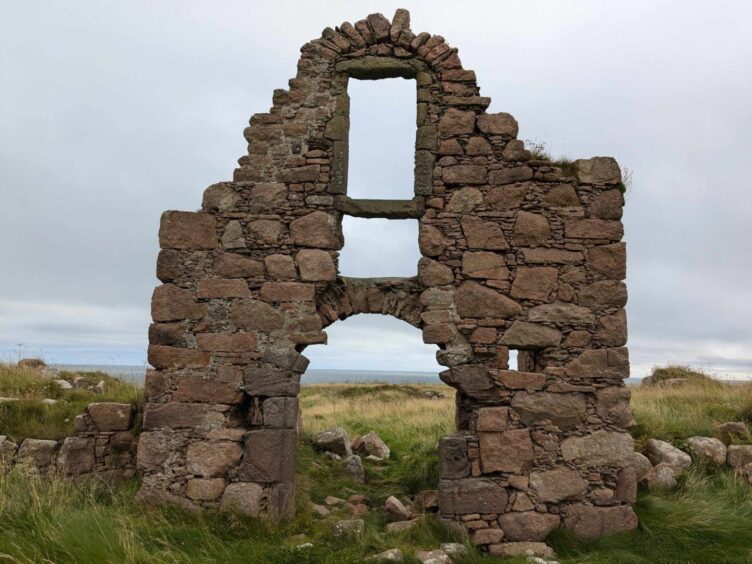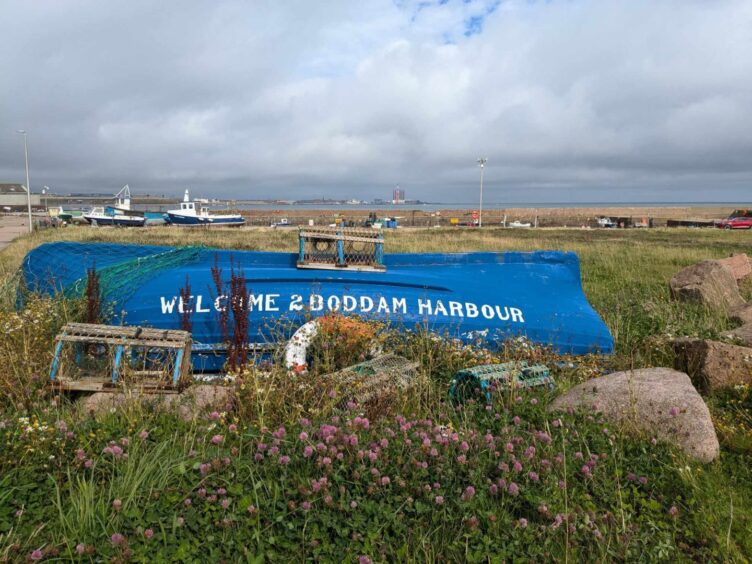No offence to anyone who lives in Boddam, but it’s always been a place I’ve whizzed past on my way up – or down – the A90.
I was well aware of its existence, of course, and couldn’t fail to notice imposing Buchan Ness lighthouse, and a scattering of ruined buildings on the outskirts of the village.
But it wasn’t until this week that I decided to stop my car, get out, and take a look around.
Boddam lies a few miles south of Peterhead, in the shadow of the town’s power station, its huge stack dominating the landscape for miles.
Parking at the harbour, I admired the colourful fishing boats and took a few snaps of lobster pots stacked in piles on the quayside.
Rock pooling opportunities
There’s plenty of scope for rock pooling on the shore, and an interpretation board, titled ‘Bandi Pots’, tells rock poolers what to look for.
If I’d been so inclined I might have found various treasures, including: dog fish egg purses; whelk egg cases; necklace shells; sea potatoes (types of urchin); and crabs galore.
Boddam is a great place for a wander, and as I wandered I spotted quite a few derelict and boarded-up buildings.
The shiny red post office, known locally as the Red Shed, closed temporarily last year after the couple who ran the branch for almost 50 years retired.
Luckily it re-opened and is still an eye-catching sight.
Also pretty special, and a sign that those who live here do so with pride, are the bright planters on the drying green, bursting with pretty flowers.
My main mission was to explore Boddam Castle, but getting there involved navigating a rather overgrown track.
I found the start point after a botched attempt, which took me down towards the ruins of Buchanness Lodge, an Italianate marine villa built in 1840 by John Smith for Lord Aberdeen.
Ruined Boddam Castle
The correct start point is at a rather old information board opposite Boddam Evangelical Church.
The castle, or what’s left of it, is a curious and yet compelling ruin.
Built in the late 16th Century as a seat for the Keiths of Ludquharn – a key family in the politics of medieval Scotland – it consisted of a modest courtyard and tower house on a promontory with cliff edges dropping sharply to the sea.
A quick internet search informed me that the “most notable early member” of the family born at Boddam Castle was Sir William Keith (1669-1749). He went on to become Lieutenant Governor of Pennsylvania and Delaware.
The Keith family’s support for the Jacobite cause saw it ruined financially and the castle fell into decay.
The remains consist of the impressive entrance archway, and the foundations.
There was once a drawbridge to access the gate tower, which was protected by gun loops.
On the north side of the courtyard was a three storey tower house of which nothing survives above the foundations.
What may have been the hinges of the drawbridge were found when a trench was cut in front of the entrance in 1868.
When the fifth and last Baronet of Ludquharn died in 1771, the castle was abandoned and later used as a quarry for building materials.
The remains are still pretty awe-inspiring, as are the views of Buchan Ness lighthouse.
Buchan Ness lighthouse
It was built in 1827 on a small island promontory – considered the most easterly part of the Scottish mainland – by the legendary Robert Stevenson, grandfather of Treasure Island author Robert Louis Stevenson.
Some fascinating facts: the lighthouse tower is 35m; 166 steps lead to the top; and the distinctive red bands were painted on the tower in 1907 to help seafarers spot it during the day.
Like most lighthouses in Scotland, Buchan Ness was automated in 1988. Its foghorn, known locally and lovingly as the Boddam Coo, fell silent in 2000.
Sadly there’s no public access – but you can rent two keepers’ cottages – so I walked round the walled enclosure on the rocky peninsula, admiring the wild coastal scenery.
Back at the harbour, accompanied by screeching seagulls, I tried to imagine what a bustling place this would once have been.
It was first constructed in 1831, but was greatly expanded in the 1840s by George Hamilton-Gordon, the 4th Earl of Aberdeen.
The famous Peterhead granite
Exportation of the famous red Peterhead granite led to further harbour improvements in the 1870s.
These included the construction of a tramway linking the quarries at Stirling Hill, a mile to the south-east, with the harbour.
The quarries also attracted a railway to Boddam, with a branch line from Ellon arriving in 1897.
However, the early 1900s saw fishing fleets lured by better harbour facilities at Peterhead.
These days Boddam harbour remains home to a few small fishing boats – and to Thistle Seafood’s fish processing plant.
The railway closed to passengers in 1932, and to freight in 1945.
After the Second World War, Boddam became home to RAF Buchan, an important Cold War radar station tracking Russian aircraft over the North Atlantic.
Until 2005 this was also home to one of the UK’s two Control and Reporting Centres, which oversaw the UK’s air defences.
There’s a wee beach at Boddam, and I spotted a couple of dog walkers encouraging their dogs to swim here. However, I didn’t feel inspired enough to take a dip.
Murdered monkey
Now I can’t write about Boddam without mentioning the tale of the hanged monkey, and I apologise to any locals who may disapprove.
The story begins with a folk song written around 1800 detailing how fishermen climbed aboard a shipwrecked boat to strip it of cargo – only to find a monkey still on board.
The law back then allowed “wreckers” to claim booty from stricken vessels, as long as no living soul remained on the boat.
When Boddam “wreckers” found the monkey, it ran up the mast – with the men then hanging it. Or so the story goes.
The “Boddamers Hung the Monkey-O” is rarely sung in the north-east now given the offence it causes, according to historian Dr Fiona-Jane Brown.
But the jest – “fa hangit the monkey” – was poked at villagers until relatively recently.
It’s thought the Noose and Monkey pub in Aberdeen was named after the tale.












Conversation